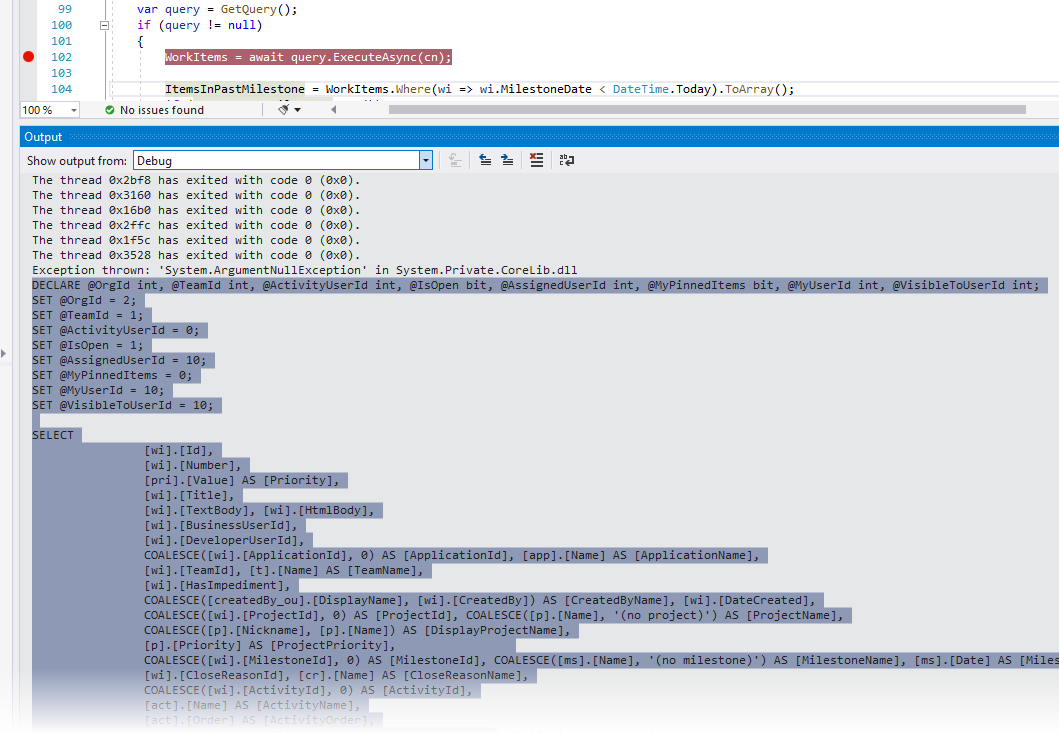Description
Nuget package Dapper.QX makes inline SQL more powerful and testable via the Query class. Get the convenience, safety and capability of Dapper with dynamic criteria, tracing, and full text queries.
Dapper.QX alternatives and similar packages
Based on the "Micro Framework" category.
Alternatively, view Dapper.QX alternatives based on common mentions on social networks and blogs.
-
.NET Micro Framework Interpreter
DISCONTINUED. Microsoft® .NET Micro Framework (NETMF) for developing embedded applications on small devices using Visual Studio
* Code Quality Rankings and insights are calculated and provided by Lumnify.
They vary from L1 to L5 with "L5" being the highest.
Do you think we are missing an alternative of Dapper.QX or a related project?
README
Nuget package Dapper.QX makes inline SQL more powerful and testable via the Query<TResult> class. Get the convenience, safety and capability of Dapper with dynamic criteria, tracing, and full text queries. From the Wiki: Why Dapper.QX?
public class MyQuery : Query<MyResultClass>
{
public MyQuery() : base(
@"SELECT *
FROM [whatever]
{where}
ORDER BY [something]")
[Where("[SomeDate]>=@minDate")]
public DateTime? MinDate { get; set; }
[Where("[SomeDate]<=@maxDate")]
public DateTime? MaxDate { get; set; }
[Case("0", "[AssignedTo] IS NULL")]
[Case("-1", "[AssignedTo] IS NOT NULL")]
[Where("[AssignedTo]=@assignedTo")]
public string AssignedTo { get; set; }
}
Run your query like this:
using (var cn = GetConnection())
{
var data = await new MyQuery()
{
MinDate = DateTime.Now,
MaxDate = DateTime.Now.AddDays(30),
AssignedTo = "somebody"
}.ExecuteAsync(cn);
}
In the example above GetConnection is a fictional method -- you will need to provide your own method that returns an IDbConnection that works in your project. Read on below for an alternate syntax that lets you omit the using block.
Use {where} or {andWhere} tokens to indicate where dynamic criteria is inserted. Mix and match Where and Case attributes on query class properties to control what criteria is injected. Learn about more attributes Dapper.QX offers.
Note that you can omit the using block if you use the Execute* overloads that accept a Func<IDbConnection> instead of IDbConnection. This assumes you still have a method in your project that returns IDbConnection. Adapting the example above, this would look like this:
var data = await new MyQuery()
{
MinDate = DateTime.Now,
MaxDate = DateTime.Now.AddDays(30),
AssignedTo = "somebody"
}.ExecuteAsync(GetConnection);
This approach makes sense when you have just one query to run, and you don't need the database connection for anything else.
Tooling
To help you build C# result classes for any SQL query, I offer a free tool Postulate.Zinger.
Testing
Make query classes testable by basing them on TestableQuery. This approach catches invalid SQL, but does not assert any particular query results.
Note that you can also use the interface ITestableQuery directly if you wish, but you must implement TestExecute yourself. There's normally no reason to do this, since I use the same implementation everywhere. Therefore, I recommend using the abstract class TestableQuery instead of ITestableQuery.
public class MyQuery : TestableQuery<MyResultClass>
{
// same code above omitted
// implement GetTestCasesInner method to return every parameter combination you need to test
protected IEnumerable<ITestableQuery> GetTestCasesInner()
{
yield return new MyQuery() { MinDate = DateTime.Now };
yield return new MyQuery() { MaxDate = DateTime.Now };
yield return new MyQuery() { AssignedTo = "0" };
yield return new MyQuery() { AssignedTo = "-1" };
yield return new MyQuery() { AssignedTo = "anyone" };
}
}
Now, in your unit test project, use the QueryHelper.Test method for each of your queries. A good way to test queries on a SQL Server localdb instance is to use my SqlServer.LocalDb.Testing package. You can see how it's used in Dapper.QX's own tests.
[TestClass]
public class QueryTests
{
private SqlConnection GetConnection()
{
// implement as needed
}
[TestMethod]
public void MyQuery() => QueryHelper.Test<MyQuery>(GetConnection);
}
Debugging
To help you debug resolved SQL, place a breakpoint on any of the Execute* calls, and step over that line. Look in the Debug Output window to see the resolved SQL along with any parameter declarations. You can paste this directly into SSMS and execute.

Note the extra indent you're seeing in the SQL is because of whitespace in the sample query's source file from where I took this screenshot. In the source file, the SQL is stored with a verbatim string, so the indent is preserved.
Please see also my Crud library Dapper.CX, Dapper.QX's companion library.



